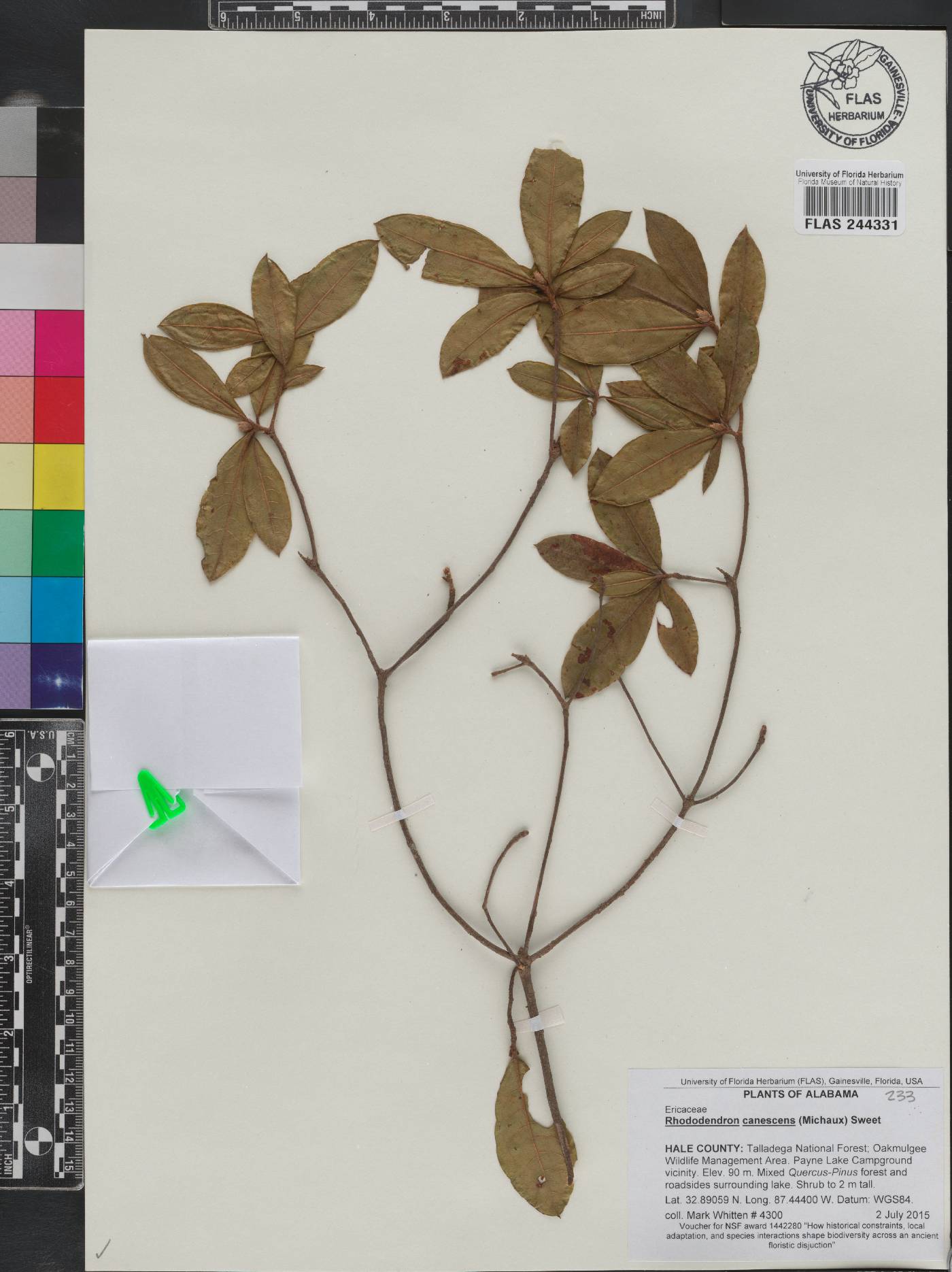|
|
|
|
Family: Ericaceae
mountain azalea
[Azalea candida Small, moreAzalea canescens Michx., Azalea canescens var. subglabra (Rehder) Small, Azalea lutea L., Rhododendron candidum (Small) Rehd., Rhododendron canescens var. candidum (Small) Rehder, Rhododendron canescens var. subglabrum Rehder] |
Shrubs or trees, to 6 m, usually not rhizomatous. Stems: bark smooth to vertically furrowed, shredding; twigs scattered, multicellular eglandular- and/or stipitate-glandular-hairy (hairs unbranched), otherwise moderately to densely unicellular-hairy. Leaves deciduous; petiole usually multicellular eglandular- or stipitate-glandular-hairy, also unicellular-hairy; blade ovate to obovate, 2.5-10(-13) × 1.2-3(-4) cm, thin, membranous to chartaceous, margins entire, rarely minutely serrulate, plane, inconspicuously ciliate, eglandular-hairy (hairs appressed to margins), apex acute to obtuse, often mucronate, abaxial surface densely to sparsely unicellular-hairy, sometimes glabrous or glabrate, often also scattered eglandular-hairy, adaxial surface usually scattered eglandular-hairy, otherwise sparsely unicellular-hairy, sometimes glabrous. Floral bud scales ± densely unicellular-hairy abaxially, margins usually unicellular-ciliate. Inflorescences 6-19-flowered; bracts similar to bud scales. Pedicels 4-17 mm, usually eglandular-hairy, rarely stipitate-glandular- and/or eglandular-hairy, otherwise sparsely to densely unicellular-hairy. Flowers opening before or with leaves, erect to horizontal, fragrant (usually musky-scented); calyx lobes 0.5-4 mm, surfaces and margins scattered stipitate-glandular- and/or eglandular-hairy, otherwise usually densely unicellular-hairy; corolla deep pink to white with pink tube, without blotch on upper lobe, funnelform, 23-46 mm, scattered, multicellular stipitate-glandular-hairy (hairs not forming distinct lines), otherwise sparsely to densely unicellular-hairy on outer surface, petals connate, lobes 7-20 mm, tube ± gradually expanded into lobes, 13-27 mm (equaling or longer than lobes); stamens 5, much exserted, ± unequal, 31-64 mm. Capsules borne on erect pedicels, 12-33 × 3-6.5 mm, usually sparsely to moderately eglandular-hairy, otherwise ± densely unicellular-hairy. Seeds without distinct tails, flattened portion of testa well developed at each end; testa expanded, dorsiventrally flattened, ± loose. 2n = 26. Flowering spring. Moist to dry woods, pocosins, swamps and savannas, often along streams; 0-500 m; Ala., Ark., Fla., Ga., Ill., Ky., La., Miss., N.C., Okla., S.C., Tenn., Tex. Rhododendron canescens is most similar to R. prinophyllum and R. periclymenoides, although these three species do not constitute a clade (K. A. Kron 1993); they occasionally hybridize where their habitats and ranges overlap. In addition, putative hybrids with R. alabamense, R. atlanticum, R. austrinum, R. flammeum, R. periclymenoides, and R. calendulaceum are known.
Tall shrub, sometimes to 5 m, usually not colonial; lvs felty-pubescent beneath; pedicels and cor-tube densely and finely pubescent as well as stipitate-glandular; cor white to more often pink, the tube longer than the lobes, rather abruptly expanded to the limb; stamens ca 3 times as long as the cor-tube; ovary densely strigose, fr sparsely so, not glandular. Moist woods; chiefly on the piedmont and coastal plain; Del. to Fla. and Tex. Apr., early May. Gleason, Henry A. & Cronquist, Arthur J. 1991. Manual of vascular plants of northeastern United States and adjacent Canada. lxxv + 910 pp. ©The New York Botanical Garden. All rights reserved. Used by permission. |


